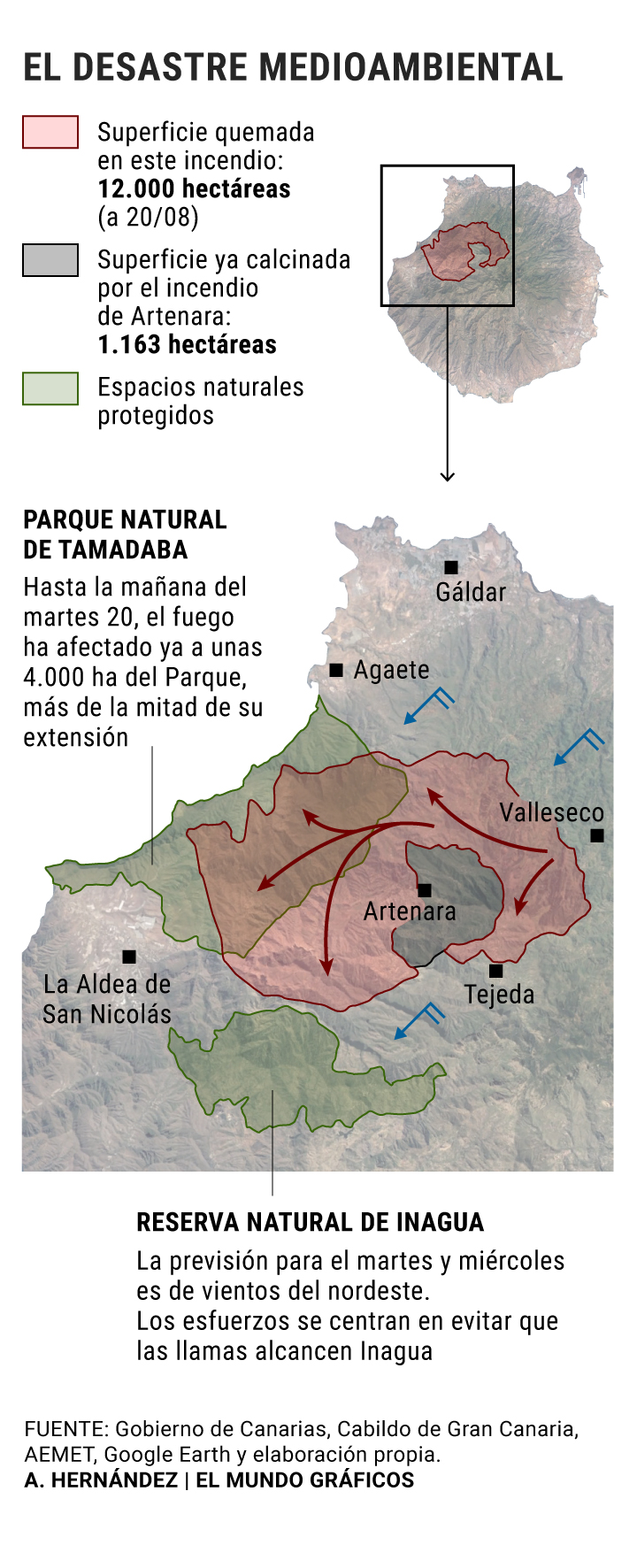- Events: A ray of hope for the "inextinguishable" fire in Gran Canaria: "We are going to win this beast"
- Canary Islands. Gran Canaria fire: the fire advances "out of extinction capacity" with 9,000 evacuees
- Album.The fire of Gran Canaria, the third in a week, in pictures
Ángel Víctor Torres , president of the Canary Islands, said yesterday that the forest fire that burns the northwest of Gran Canaria since Saturday "loses potential". But the llamas have already burned 12,000 hectares after passing through the island and threw 10,000 people out of their homes, according to Canarian government sources.
In 700 shelters authorized by the administration, 700 Grancanarian neighbors are currently waiting to return to their homes. In fact, some inhabitants of Tejeda , La Aldea , San Bartolomé de Tirajana and San Mateo , were able to return to their homes yesterday afternoon.
The fire, which has come to dominate a perimeter of 80 kilometers, reached «50 meters» high in some points of the Tabadaba National Park , whose pines of «25 meters high» have served as food for the llamas, according to Florencio López , head of Civil Protection of the Canary Islands .
However, thanks to the efforts made by the large contingent deployed on the island, with 700 troops deployed and 18 air means, and the benevolence of the weather, firefighters have been able to control the flames in certain areas. The problem is the consequences that begin to glimpse.
The most serious is the possible destruction of some endemic plants in the burning of 2,500 hectares, especially important for the biodiversity of Gran Canaria. For example, the lock of Don Enrique who, according to Manuel Nogales , delegate in the Canary Islands of the Higher Centers for Scientific Research (CSIC), "has less than one hundred copies registered in the world and is in the area affected by the fire." In this sense, Nogales explains to EL MUNDO that "up to eight species of native plants" have been affected by fire and their possible disappearance is feared. In any case, he says that "we will have to wait for the fire to be stifled to determine the real extent of the damage."
Even so, although it has been feared for the destruction of Tabadaba, it clarifies that "it has been a fire a little more surface, less destructive", which means that the protected pine forest has only suffered superficial damage. In fact, the head of Canarian Civil Protection maintains that the area can be recovered in "about three or four years" since "the Canarian ecosystems are very familiar with the fires. It is not like in the Peninsula, which can take 60 or 70 years.
Despite Florencio López's optimistic prognosis, Nogales considers that "in order for the entire area affected by the fire to fully recover and be as before, at least 10 years remain."
As for the fauna, "the change of winds and luck" prevented the fire from spreading to the south and entering the reserve of Inagua , home of the Blue Finch , a native bird of which only about 400 copies remain. However, the CSIC biologist adds that there are species of reptiles or other affected birds such as the Rabiche Dove , which in recent years had tried to reintroduce itself to the Canarian ecosystem after its disappearance.
For their part, the Canarian authorities said that the vast fire has barely had an impact on the tourism of Gran Canaria, vital in the economy of the archipelago, since tourists are in the accommodation near the coast, where the fire has not reached . In this sense, ports and airports work normally. The island's road network, in contrast, is not fully operational, as 21 of them remain cut, close to the Gran Canaria summit.
According to the criteria of The Trust Project
Know more- THE WORLD
- Canary Islands
- Events
- Fires
Events A ray of hope for the "inextinguishable" fire in Gran Canaria: "We are going to win this beast"
Fire The fire in Gran Canaria remains uncontrolled and the fire already affects 1,500 hectares
Llucmajor The critical wound in the fire of El Arenal life was played to save his dogs

